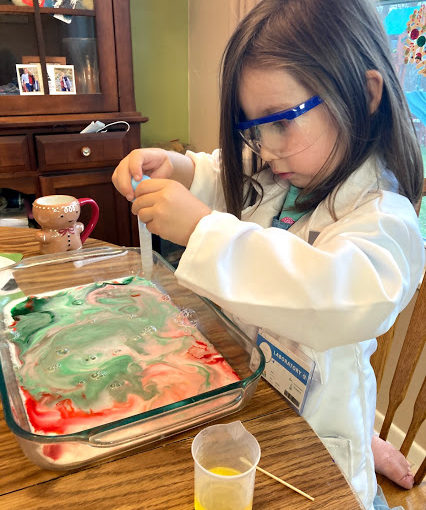My daughter can’t get enough of science experiments. She will ask for one after another. I don’t always have all of the ingredients around but rain cloud in a jar is a simple experiment with materials you will have on hand!
You will need:
- blue food coloring (or hey-you could do any color, go for the rainbow)
- shaving cream
- dropper
- water
- clear mason jar/vase/glass
Fill the glass jar with 3/4 cup of water (leave room for the “clouds” aka shaving cream). Next put some shaving cream on top. We went a little crazy as Maddy wanted a giant cloud (cumulus-big, white & fluffy). You could also talk about the different types of clouds: cumulus, cirrus, stratus, nimbus. There are more clouds but those are the main 4 and that would be more for older elementary students. This cloud demonstration could be fun for any level!
After putting the shaving cream on top get a bowl or small cup and mix a few drops of food dye with water. This will be the rain.
 Have your child use the dropper to get some rain and put it on the clouds. This works best if you insert the dropper about half way into the clouds and squirt it out.
Have your child use the dropper to get some rain and put it on the clouds. This works best if you insert the dropper about half way into the clouds and squirt it out.
Soon they will see rain fall through the clouds when they get so full of the water they can’t hold it anymore!
This can be repeated with different colors and different amounts of liquid. You can have your child hypothesize what they think will happen before they put the drops in and make a conclusion afterward.
The science behind this: Clouds are made when water vapor (gas) turns into liquid water droplets. They form on little particles that are floating in the air (like dust).
If you see puddles outside but then they disappear where did they go? They evaporated (liquid to gas-water vapor). The water vapor travels through the atmosphere to create the clouds. When too many water droplets are in the clouds and it gets saturated, it rains. This is a very simplistic version of some of the water cycle but if you want to dig in more I suggest going here: https://www.nasa.gov/audience/forstudents/k-4/stories/nasa-knows/what-are-clouds-k4.html . If you scroll down there is also a link at the bottom of that website explaining how clouds form for kids in grades 5-8.
FollowShare








